Replacing the bearing in the washing machine: how to change the bearing yourself and not make mistakes
When a bearing has flashed at the washing machine, measures should be taken immediately. Continued use of the unit with such a breakdown invariably ends in fatal destruction for it.
Timely detection of a malfunction and a manual replacement of the bearing in the washing machine will cost much less than paying for the services of a master or buying new equipment. In our article, we will analyze this process in detail, starting with step-by-step instructions for disassembling the washer, removing worn bearings, and ending with the stage of installing new ones.
The content of the article:
Signs of damage to the bearing assembly
Failures depend on various factors, including the quality of the equipment assembly and its age.
Troubles can happen for the following reasons:
- due to a worn oil seal, the bearing assembly destroys moisture;
- violated the rules for installing the washing machine (instructed on the correct installation is given here);
- regular tank overload.
There may be such a nuisance as the initially poor quality of the bearings themselves.
Often it’s real to hear about a breakdown even by ear.
The signs of a bearing assembly malfunction are eloquently signaled by the signs:
- the drum does not spin after turning on the washing program, although the motor is running (other causes of such damage are discussed in this article);
- the drum rotates, but makes an atypical grinding noise, and sometimes even a rumble, the washing machine vibrates substantially;
- the washed laundry is not wrung out (we talked more about noise and lack of spin in other material).
Having decided to cope with such interference on your own, you need to clearly understand that this is a very time-consuming process related to overhaul, in which virtually the entire washing machine must be disassembled.
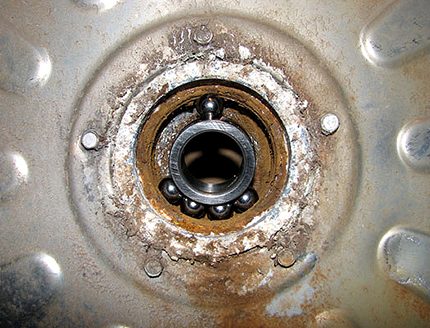
When the final decision is made on self-repairing the breakdown, in order not to aggravate the situation, it is necessary to stop the operation of the faulty mechanism and prepare for repair.
What tools are needed?
First of all, before serious work, you need to take care in advance of the spare parts and tools that will be required during the repair.
Set of tools:
- pliers;
- open-end wrenches of various diameters;
- hammer;
- a metal rod with a diameter of a pencil or a blunt chisel;
- Phillips and slotted screwdrivers.
You will need a silicone sealant and a grease designed for bearings placed in washing machines that are not afraid of water.
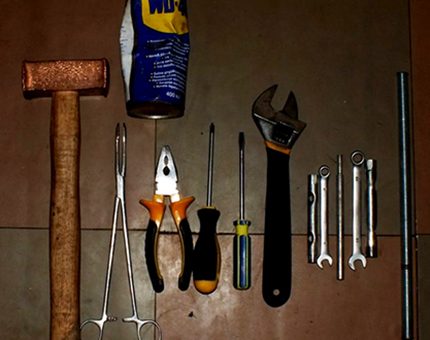
From spare parts, it is necessary to purchase an oil seal and 2 bearings. Parts are ununified, but in stores by brand of equipment they will pick up what is needed.
You can also, having disassembled the car and taking out the old parts, by the numbers on them to find and write out the necessary details on the Internet.
You should not save: the service life of the washing machine is directly dependent on the quality of the parts. Ultimately, cheap counterparts will cost more than branded parts.
Stages of disassembling the washing machine
First of all, the washing machine must be disconnected from the communications, supplying it with water and electricity, providing drainage. To get to a broken bearing, you will have to remove the tank, and for this, disassemble virtually the entire machine.
A camera or cell phone with a similar function will not be amiss to fix all the stages of disassembly.
When assembling, such forethought can be invaluable, because 100% relying on memory is more than risky. In extreme cases, the whole process needs to be recorded, especially the order of the wires.
Step # 1 - remove the cover and dashboard
The cover is first removed. To do this, by unscrewing 2 self-tapping screws on the back wall, it is lifted by moving slightly back.
The next task is to remove the tray for washing powder. He will leave the grooves quite freely if, by pulling out and pressing a special latch, pull it towards himself.
In models that are not equipped with such a button, the powder receptacle can be pulled out by slightly pushing it down.
Before you remove the upper dashboard, you need to determine where the bolts holding it are located. The location and number of them depending on the model may be different, but in the place where the powder tray was pulled out, some of the screws are located exactly.
Another one is always placed on the right side of the washing device. If after unscrewing them the panel does not want to be removed, you need to continue the search for missing fasteners.
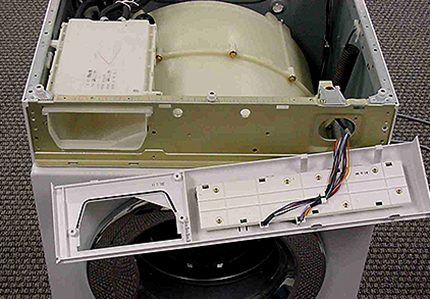
Before you disconnect a whole bunch of wires going to the control board, they must be photographed - this will greatly help with the reverse connection.
Next, you need to remove the bottom panel: after pressing a flat screwdriver on the latches holding it, it is easily released.
Step # 2 - release the hatch, remove the front wall
The next step will be the release of the cuff, that is, the rubber gasket, one side worn on the tank, and the other on the front panel of the washing machine. It is fixed by a spring and a clamp. More details on the withdrawal process we reviewed in of this instruction to replace the cuff.
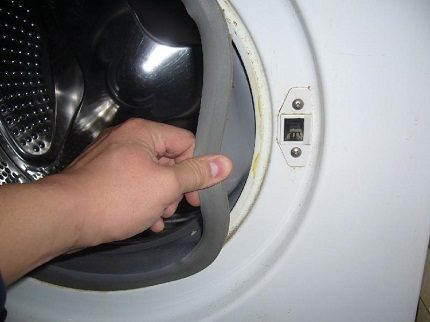
It was the turn to dismantle the front wall. To do this, when the hatch is latched, the bolts holding the panel are removed and carefully removed from the hook, remembering the wire connecting the panel and the hatch lock.
As soon as possible, the wire should be disconnected. There are no obstacles to remove the wall.
Step # 3 - remove the heater, wiring and tank
First of all, the inner upper panel is removed, for which, in the back of the device, the screws that secure the valve for supplying water are searched for and removed. After that, the twisting of the bolts on the panel begins.
But in a hurry to immediately remove it is not worth it - before this action should be disconnected, not forgetting to remove the camera, wires and pipes.
The following is the dismantling of the drain pipe articulated to the tank by means of a clamp. The clamp is unscrewed, the pipe is removed. It is not out of place to have a rag on hand, as the remaining water may leak from the nozzle.
The heating element must also be removed. To do this, disconnect the wires suitable for the heater.
In different models, the location of the heater is possible both in the front and in the back of the automatic washing machine, so you need to be prepared for dismantling the rear wall.
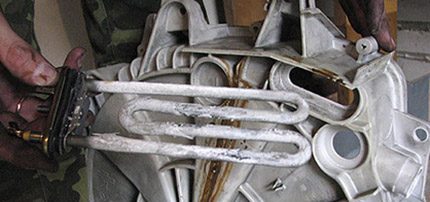
At this point, the wiring is completely dismantled. It must be borne in mind that sometimes it is attached to different parts of the unit by different types of fasteners. For example, it can be attached to the tank with ties or wire.
Next, the wires are removed from the engine. You can also disconnect the wiring from the pump and put it out so that it does not create unnecessary interference when it comes time to remove the tank.
To make it easier to remove the tank, you should remove the balances - lower and upper. Depending on the model, they can be found both in the front of the case and in the back.
Using a wrench, the bolts that fix the shock absorbers and the water level sensor in the right position are removed.
After removing the belt and disconnecting the engine and shock absorbers, the work of removing the tank from the bowels of the machine approaches the final. The tank was left hanging only on the springs, it weighs a little, so you won’t need much effort.
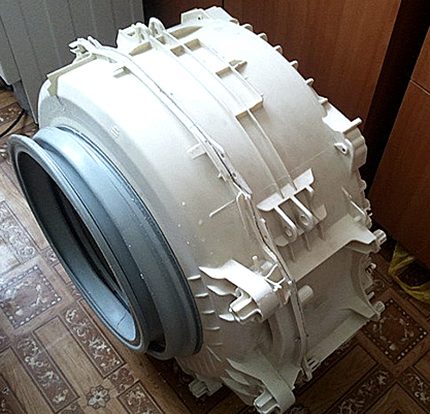
For convenience during the upcoming disassembly, the released tank is usually placed on a solid table with its pulley up.
Step # 4 - disassemble the dismantled structure
In order not to accidentally ruin the rubber cuff during operation, it is preferable to remove it, not forgetting to mark the correct location with a marker.
The tank is usually made of 2 parts fastened together. Fasteners, depending on the make of the machine, can be special latches or bolts. These halves need to be disconnected. There are, however, solid tanks that need to be sawn.
In traditional cases, after the front of the tank is removed, a drum can be seen on its rear half, which can already be removed without hindrance.
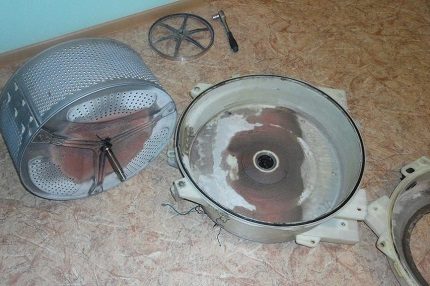
Step # 5 - open the solid tank
In some models, especially the brands Ariston and Indesit, there are not collapsible, but solid tanks made of polycarbonate.
In such cases, in order to get to faulty bearings, the container will have to be cut with a conventional hacksaw for metal.
To cut the thickness as small as possible, the saw blade is tapped with a hammer to minimize tooth wiring.
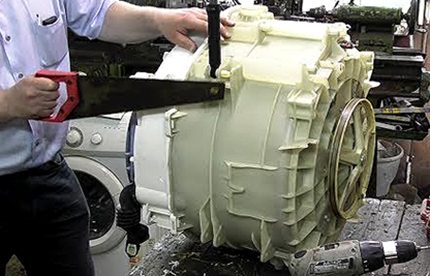
Cut halves are coated with sealant and twisted by self-tapping marks according to pre-applied marks.
For different brands, the process of disassembling the washer has its own nuances. We have a website detailed disassembly instructions on the example of models of popular brands - LG, Electrolux, Samsung, Ariston and Atlant.
Step-by-step replacement of worn bearings
The case is gradually moving towards completion, and soon it will be possible to get rid of faulty bearings, but there are still several preliminary actions.
Stage # 1 - preparatory work
Now you need to carefully disconnect the drum from the back of the tank - a responsible operation that needs increased attention.
First you need to free yourself from the fasteners holding the pulley. The tank is turned upside down with a pulley, the bolt securing it to the shaft is disconnected. When the pulley from the axis is removed, the unscrewed bolt is returned to its place in order to avoid damage to the shaft when the drum is knocked out.
The shaft is removed gradually by careful tapping of the hammer. Some experts advise inexperienced craftsmen in this case to use a rubber mallet so that, inadvertently, they do not expand the bearing housing.
If the shaft is slowly being fed, work continues patiently. If the result is negative, before increasing efforts, the standard bolt should be replaced with one that is not a pity to throw out in case of deformation.
When the position of the shaft is equal to the head of the bolt, the latter is twisted, the drum is pulled out.
It is necessary to carefully inspect the shaft and sleeve for their integrity. For testing, a new bearing can be put on the shaft to ensure that there is no or no play. If flaws are found, the shaft with the spider will have to be replaced.
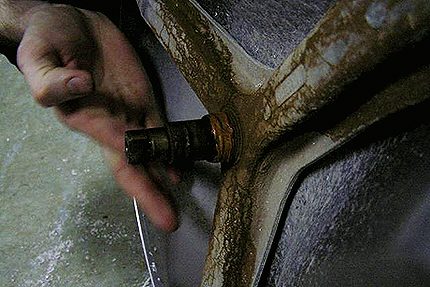
On the sleeve located on the shaft, there should also be no defects from production and mechanical damage.
The pronounced transverse grooves eloquently say that the stuffing box on such a sleeve will not be able to protect the bearing from moisture, and, therefore, re-repair is inevitable.
Before removing the bearings, the oil seal must be removed. The operation is elementary: pick up with a flat screwdriver and remove. If it does not work out right away, you will have to soak it with penetrating grease.
There will be no harm if the oil seal breaks, it is still subject to replacement.
Stage # 2 - removal of the damaged part
The tank is placed on wooden blocks, and the turn of work comes with a metal rod or a blunt chisel. Attaching the pin to a worn bearing, hit the part with a hammer.
Subsequent strokes are applied in a circle until the part is knocked out. During operation, care must be taken that the bearing does not warp. The first to remove the outer bearing.
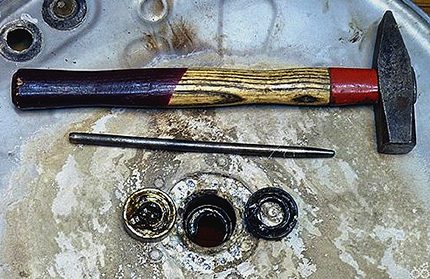
In the same way they get rid of the second bearing. Blows must be neat and light. Nevertheless, this procedure is quite noisy, so the neighbors will be grateful to the craftsman if he finds the opportunity to make it outside the walls of the house.
Landing places with descaling agents and soft tissue must be carefully, to a shine, cleaned from dirt to prevent clogging of new parts.
Stage # 3 - installing new bearings
Now nothing prevents the installation of serviceable bearings. This is initially done with the smaller.
A metal rod will help here: it is alternately applied to the bearing from opposite sides and guided by careful hammer blows to the right place.
The fact that the part is placed correctly will be reported by the sound: it will become much louder. The larger bearing also changes in the same way.
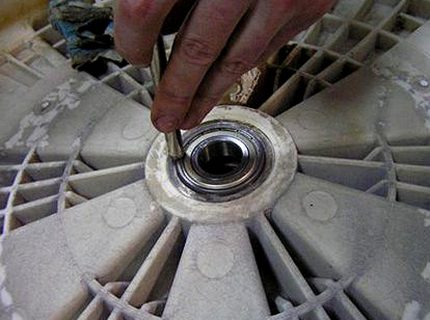
It remains to install a new oil seal. First of all, it must be treated with grease created specifically for washing machines. Only after that it can be placed in its place.
When this is not, some recommend Litol-24, which can be bought at any car shop. But the responsible masters categorically do not advise doing this. He does not have great water resistance, and what carries moisture to the bearings is clear to everyone.
Stage # 4 - assembly of the structure in reverse order
The lubricated shaft of the tank is installed at the previous address - in the back cover. Before connecting the halves of the tank, it is recommended to replace the rubber band with a new one. In extreme cases, fill the groove in a circle along with the gasket with a layer of sealant.

It remains to assemble the car. Do this in the reverse order of disassembly. And here the photos that he took when he dismantled the unit will provide an invaluable service to the home master.
The more there are, the less likely it is that “extra” details will remain near the assembled washer.
Features of repair with vertical loading
Here the drum is supported on 2 axles and 2 bearings. With such a reliable design, they fail infrequently, usually when there is still some kind of breakdown.
Often they are spoiled by water penetrating through a faulty oil seal. Rusting, steadily clogging up dirt, the bearing eventually fails.
Repairing such machines is much more convenient. When communications are disconnected, remove 2 side covers of the case, and access to the front of works is provided.
First replace the bearing from the side where there is no drive pulley. To do this, the caliper is removed - a ready-made set of bearings and an oil seal enclosed in a housing.
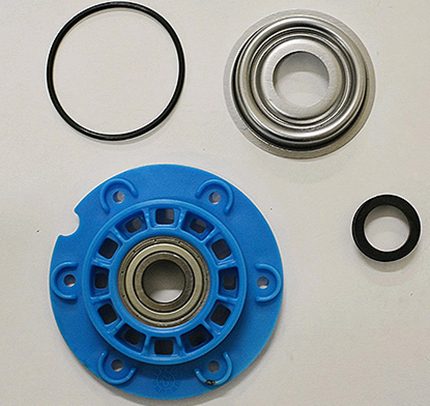
The gland, as well as the shaft itself, is free from contamination. When installing a new bearing, it is necessary to avoid distortion of the sealing ring.
Otherwise, it will not be able to prevent fluid leakage, which will cause a new bearing breakdown.
Change the caliper on the motor side by removing the belt and pulley of the drum. Then comes the turn of the ground block. Following the caliper unscrews. The shaft and mounting seat, as in the first case, are thoroughly cleaned.
A working gland is installed in its proper place, the caliper is twisted. It’s not worth putting a lot of effort, because the thread is made on plastic. Assembly, as usual, is carried out in the reverse order.
We also have a separate article on our website that details the process. bearing replacement in the Indesit washing machine.
Conclusions and useful video on the topic
A visual representation of the intricacies of the restoration of household washing machines can be obtained from videos, where the masters share their knowledge and experience.
How to independently replace the bearing in a non-separable tank:
How to change bearings in a top-loading machine:
How to knock out the bearing race:
After the repair operations have been completed, the washing machine is working again.This can not but rejoice, because a lot of money has been saved: as a rule, for professionals, the cost of eliminating such a malfunction approaches one third of the price of a new unit.
And for a home craftsman who, in practice, knew how to change a worn bearing on a washing machine, after such a baptism of fire, new prospects for the successful repair of home appliances are opened.
Have you recently replaced the bearing on your washer and want to share your experience with other visitors to our site? Tell us about the difficulties that you encountered during the replacement process, leave your recommendations to newcomers in the comments section.
If you have any questions about disassembling the washer or installing new bearings, ask our experts below under this publication.

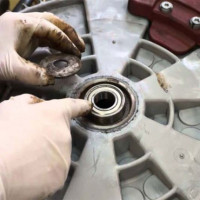 How to exchange bearings on an Indesit washing machine: step-by-step instruction
How to exchange bearings on an Indesit washing machine: step-by-step instruction  Unpleasant odor in the washing machine: causes of odor and methods for eliminating it
Unpleasant odor in the washing machine: causes of odor and methods for eliminating it 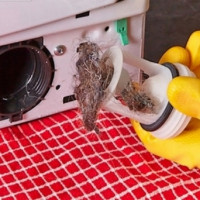 How to clean a filter in a washing machine: an overview of best practices
How to clean a filter in a washing machine: an overview of best practices 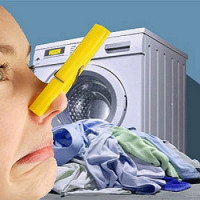 How to get rid of mold in the washing machine with improvised means at home
How to get rid of mold in the washing machine with improvised means at home 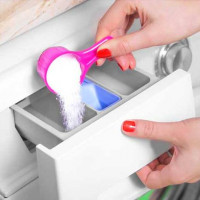 Where to put powder in the washing machine and how much powder to pour: balance of efficiency and economy
Where to put powder in the washing machine and how much powder to pour: balance of efficiency and economy  Pump for a washing machine: how to choose + how to replace
Pump for a washing machine: how to choose + how to replace  How much does it cost to connect gas to a private house: the price of organizing gas supply
How much does it cost to connect gas to a private house: the price of organizing gas supply  The best washing machines with dryer: model rating and customer tips
The best washing machines with dryer: model rating and customer tips  What is the color temperature of light and the nuances of choosing the temperature of the lamps to suit your needs
What is the color temperature of light and the nuances of choosing the temperature of the lamps to suit your needs  Replacement of a geyser in an apartment: replacement paperwork + basic norms and requirements
Replacement of a geyser in an apartment: replacement paperwork + basic norms and requirements
Once I changed the bearing at my washer. I found a similar instruction and disassembled it in a day. When pressing out a pulley gently tapped with a hammer. It seems to be no trace left. But when he began to assemble, the engine did not sit on the pulley until the end. From despair, he took up the file. After an hour of trying, everything finally fell into place. But with further operation of the machine, an extra vibration appeared, which quickly again broke the bearing. So with a hammer it is better not to approach the machine.
If you take up an unfamiliar business for the first time, Valery, be prepared that you will make some kind of mistake. Therefore, I prefer to call plumbers in such cases. There, at least an experienced person will do that has already encountered a similar problem. However, now such "professionals" are found, which is not better than lovers. You need to watch reviews, ideally use the recommendations of familiar people.
A typical mistake, of course, which I just can’t pass by. Firstly, many parts in the machine (as in other equipment) are disassembled with a hammer. Therefore, it’s not a hammer, but just a file with which you have sewn up the “excess”, which in fact was not.
In your case, everything is banal simple: the pulley was pressed in, you disassembled it, so you need to press it in to assemble it back. This is also done neatly with a hammer. If you do not press in, the pulley will not sit completely.
Now you have to change again not only the bearings, but the pulley itself. In the videos that are attached to the article, craftsmen from the structures of the repair machinery specifically focus attention on these points.